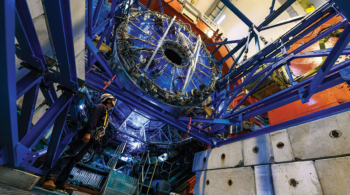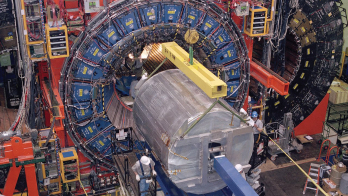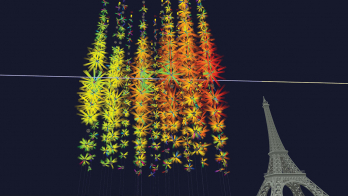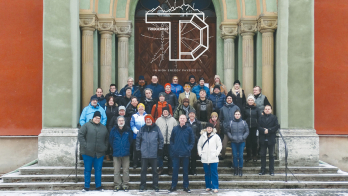The Japanese Kamiokande underground detector played a leading role in the study of neutrinos produced via cosmic rays and also helped to pioneer the subject of neutrino astronomy. With Kamiokande now having given way to Superkamiokande, the Kamioka mine becomes the scene of a new neutrino project.
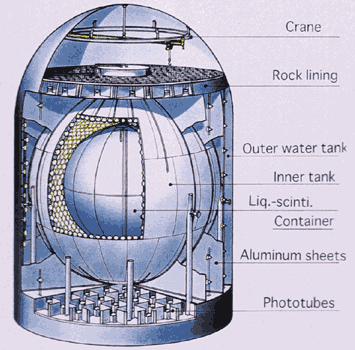
A new large neutrino detector is currently being constructed by an international collaboration that includes Hungary, Japan and the US in the underground site that used to be the home of the pioneering Kamiokande experiment. Called KamLAND (Kamioka Liquid scintillator Anti-Neutrino Detector), it will be the largest low-energy antineutrino detector ever built and will study a wide range of science, spanning particle physics, geophysics and astrophysics.
The principal goal will be to investigate the possibility of neutrino oscillations by studying the flux and energy spectra of neutrinos produced by Japananese commercial nuclear reactors. Approximately one-third of all Japanese electrical power (which is equivalent to 130 GW thermal power) is produced by nuclear reactors and KamLAND is centrally located on the main island of Honshu, therefore the experiment is exposed to a very large flux of low-energy antineutrinos, which are mainly produced at a distance of between 150 and 200 kilometres. The broad energy spectrum of antineutrinos emitted by the neutron-rich fission fragments of a reactor has a maximum at around 3.5 MeV.
Oscillation behaviour
With two kinds of neutrinos, the oscillation probability depends on one mixing parameter and on the sine of Dm2 L/En, where L is the “baseline” traversed by the neutrinos, EnDm2 is the mass squared difference. Measurements would constrain Dm2 and the mixing parameter.
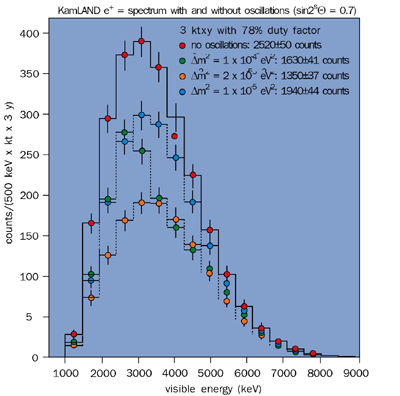
Since for a given baseline the oscillation probability depends on the neutrino energy, different neutrino energies will have different oscillation behaviour. Hence, in general, oscillations would distort and suppress the detected spectrum. With an expected (non-oscillating) rate of 700 antineutrinos detected per year, three years of data-taking would be a hundred-fold improvement over existing neutrino mass measurements.
More important is that the experiment’s sensitivity covers one of the possible solutions of the “solar neutrino puzzle”. While solar and atmospheric neutrinos have provided the first signals for neutrino oscillations, terrestrial experiments, with both source and detector well quantified, are required to investigate and understand such oscillations in detail.
While Minos in the US, K2K in Japan and a possible CERNGran Sasso beam are designed to investigate the mass region of interest for atmospheric neutrinos, KamLAND is the first attempt to study the solar neutrino puzzle “in the laboratory”. This has a historical precedent in meson physics, where the first investigations were driven by cosmic-ray experiments using balloons or on high mountains, while subsequent discoveries and systematic study came via accelerators and bubble chambers.
KamLAND will, for the first time, also be able to detect antineutrinos from uranium and thorium beta decays inside the Earth. While the present experimental data on this topic are derived from sparse and shallow samplings, KamLAND will provide a global measurement. About half of the heat produced in our planet is believed to be produced by such decays, therefore this measurement will be of considerable geophysical interest.
In addition, comparisons with similar measurements from Borexino should make it possible to calculate the ratio of uranium to thorium in the crust and mantle of the Earth. This is because Borexino is surrounded by thick continental crust, while KamLAND is located at the edge of the Asian plate and, hence, over about half of its angular coverage it receives antineutrinos from beneath the Pacific Ocean.
Recoil energy
A natural continuation of the KamLAND programme will include the direct observation of beryllium-7 and boron-8 solar neutrinos by detecting recoil energy in neutrinoelectron scattering processes. While Borexino is particularly optimized for the study of beryllium-7 solar neutrinos, the larger mass of KamLAND opens up the low-energy measurement of the rarer boron-8 neutrinos. (The high-energy component of such neutrinos will be covered by the SuperKamiokande and Sudbury (SNO) water Cherenkov detectors.)
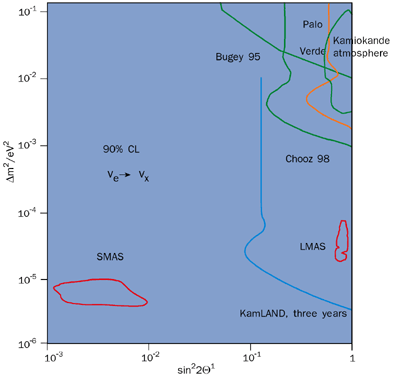
The direct detection of solar neutrinos involves single ionization events (as opposed to double in the case of reactor and terrestrial antineutrinos), thus the quality of these measurements will depend on the extent to which the radioactive contamination (and hence the background) can be controlled. Here the kiloton mass of the detector is a major asset, allowing the active scintillator volume to be separated from the external components by a very thick layer of inert shielding oil.
Should the background be higher than expected, an additional layer of scintillator will be used as shielding, with a software cut on the event position, while retaining a very large fiducial volume. Simulations show that the the KamLAND background will be dominated by the internal radioactivity of the scintillator, and by the radon produced mainly in the photomultiplier glass and carried to the centre of the detector by convection.
The first phase of running will show conclusively whether more effort is needed for precise observations of the solar neutrino fluxes to be made. Such a staged approach minimizes expense and effort in the notoriously tricky field of detector background. Searches for supernova neutrinos, solar antineutrinos and, possibly, neutrinoless double beta decay will complete the physics programme.
The heart of KamLAND will be a spherical volume containing a kiloton of very-high-purity liquid scintillator. Unlike water Cherenkov detectors that can only detect relatively high-energy particles, KamLAND’s scintillator has enough sensitivity to detect fractions of a mega electron volt, with the possibility of background-free low-energy electron-type antineutrino detection. This would be achieved by observing both the positron and the neutron produced by the inverse beta decay capture of antineutrinos by protons.
Fake events resulting from natural radioactivity and cosmic-ray backgrounds are reduced by different layers of shielding, the careful selection of construction materials and event signature.
Scintillation
The active scintillator volume is housed in a 2.5 m thick layer of ultrapure mineral oil that shields it from external neutron and gamma radiation. Scintillation light is picked up by an array of about 2000 specially developed photomultipliers achieving 3.5 ns time resolution using a very large (17 inch diameter) photocathode. While good time resolution is essential to localize events within the fiducial volume, an important feature is the novel approach of its electronics, thus providing a complete history of the signals from each tube preceding and following triggered events. This will be invaluable in suppressing backgrounds, either using the scintillator pulse shapes produced by different types of particle or by studying correlations in radioactive decay chains over a broad timescale range.
An advanced system of buffering will ensure no deadtime up to several kilohertz during several 1 s bursts. The active scintillator is separated from the buffer oil by a very thin layer of transparent plastic a 13 m diameter weather balloon! This is a critical component of the detector, allowing scintillation light to reach the photomultiplier tubes, but blocking the radon from uranium contamination in external materials. The 3000 tons of liquid scintillator, buffer oil and photomultipliers are contained and supported by an 18 m diameter stainless-steel sphere. The volume between the sphere and the cylindrical cavity in the rock is flooded with water in which cosmic-ray muons are detected by their Cherenkov light. The read-out of this veto detector is provided by the old Kamiokande photomultipliers.
By recycling and upgrading existing facilities,
a new “superdetector” will rise from the “ashes” of Kamiokande for a modest investment. KamLAND’s schedule foresees the exploration of neutrino physics,
geophysics and astrophysics from the beginning of 2001.


